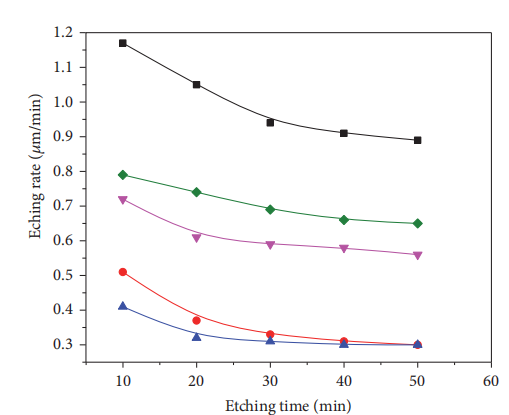A micropyramid structure was formed on the surface of a monocrystalline silicon wafer (100) using a wet chemical anisotropic etching technique. The main objective was to evaluate the performance of the etchant based on the silicon surface reflectance. Different isopropyl alcohol (IPA) volume concentrations (2, 4, 6, 8, and 10%) and different etching times (10, 20, 30, 40, and 50 min) were selected to study the total reflectance of silicon wafers. The other parameters such as NaOH concentration (12% wt.), the temperature of the solution (81.5∘ C), and range of stirrer speeds (400 rpm) were kept constant for all processes. The surface morphology of the wafer was analyzed by optical microscopy and atomic force microscopy (AFM). The AFM images confirmed a well-uniform pyramidal structure with various average pyramid sizes ranging from 1 to 1.6 𝜇m. A UV-Vis spectrophotometer with integrating sphere was used to obtain the total reflectivity. The textured silicon wafers show high absorbance in the visible region. The optimum texture-etching parameters were found to be 4–6% vol. IPA and 40 min at which the average total reflectance of the silicon wafer was reduced to 11.22%.
One problem in the texturing process is the generation of H2 bubbles that attach to the wafer’s surface causing the formation of big pyramids and low uniformed surface texture (Figure 2). Many studies reported that adding isopropyl alcohol (IPA) increases the wettability of the silicon surface and then removes the adhering hydrogen bubbles sticking on the surface, leading to an increase in the uniformity of the random pyramids. The other effect of adding IPA is that it strongly decreases the etching rate of the silicon wafer. Additionally, few studies focused on the amount of IPA ensuring the improvement of the surface morphology in the etching process.
For laboratorial and industrial c-Si solar cells, a silicon base with a resistivity of ∼1–3 Ω⋅cm is commonly used,which has been empirically found to provide a good balance between solar cell parameters. Therefore, a major number of literatures study the texturing process using Si wafers that have a resistivity of ∼1 Ω⋅cm. However, decreasing base resistivity provides a way to increase 𝑉oc and, accordingly, potentially the cell efficiency as well. Brody et al. (2001) described the relation between the base resistivity of silicon solar cells and the cell efficiency, and they concluded that the optimal base resistivity should be lower or even much lower than the commonly used wafers.
In this paper, a texturing process on low-resistivity silicon wafers (∼0.1 Ω⋅cm) in NaOH solution with the addition of IPA has been studied. The experiments were carried out with different IPA concentrations at 81.5∘ C (near the boiling point of IPA, 82∘ C) for different etching times, and the range of stirrer speeds (400 rpm) was involved. Detailed analyses of the surface phenomena, etching rates, surface morphology, and surface total reflectance have been carried out.
Etching Rate. The texturing process was carried out for the silicon samples in solutions of 12% wt. NaOH with various concentrations of IPA (2, 4, 6, 8, and 10% vol.) and for several etching times: 10, 20, 30, 40, and 50 min. In order to study the stability of the texturing process, the changes in the average etching rate with etching time and concentration of IPA were analyzed as shown in Figure 5.
It appears that 𝑅etch decreases with increasing 𝑡etch. After 40 min, no further reduction of 𝑅etch is observed in all solutions and this may be attributed to the strong dependence of the etching rate on the crystal orientation. At the beginning, solutions etch the Si wafer surface, that is, ⟨100⟩ orientation, with the highest etching rate. With time, ⟨111⟩ facets, which are etched with the lowest etching rate, are formed and all other orientations disappear. Figure 6 shows 𝑅etch as a function of 𝐶IPA at 𝑡etch = 40 min.

Fig2
The influence of IPA concentration and the etching time on the pyramidal surface structures was realized on etched mcSi samples in alkaline solutions. Both 𝐶IPA and 𝑡etch were optimized based on the reflectance measurements. The optimization of the process variables yields the condition 𝐶IPA = 4–6% vol. and 𝑡etch = 40 min. The obtained surface was covered uniformly with ∼1.3 𝜇m size pyramid structure and it has an average total reflectance of less than 11.22% on the visible range. These conditions have an optimal light trapping effect and are suitable for archiving the highest efficiency of solar cells compared to that with other etching conditions.
上一篇: 氧化剂溶液中碳化硅的摩擦化学抛光
下一篇: Si多层膜的选择性化学湿法蚀刻